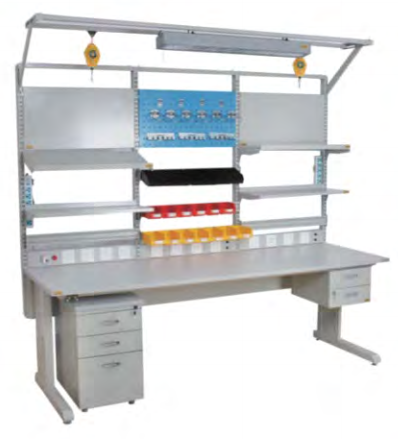Since the automotive industry continued to evolve there has been increased demand for complex vehicle electronics. Advanced workspaces matching the requirements emerged as a direct result of the electronics transition for sensitive components. The automotive electronics industry demands specially customized Electrostatic Discharge (ESD) workbenches which provide unique solutions for their specific requirements.
Integrated Power Outlets and Tool Storage
The workplace for modern automotive electronics offers functions beyond basic surfaces. Modern workbenches for automotive electronics bring together electrical power provision and optimized tool organizing functions into one unit. Accommodating professionals who work with automotive electronics depends heavily on their access to power sources. The workbenches feature adjustable power outlets that allow various tools to operate directly from the table without compromising its organization.
The design of built-in power outlets enables technicians to simultaneously operate numerous electronic tools between their works. Testing and automotive electronic troubleshooting requires such a power setup because technicians need to apply electricity to multiple devices while simulating practical scenarios.
The layout of efficient tool storage tools remains essential to keep an organization workspace. The construction of customizable ESD workbenches includes storage solutions including drawers, shelves and pegboards which specifically accommodate the tools required for automotive electronics maintenance. The tailored setup guarantees every tool finds specific organization which eliminates tool loss incidents while improving operational speed.
Such systems increase efficiency along with maintaining workplace cleanliness while both factors prove critical to handling sensitive automotive electronics.
Anti-Vibration Design
Academic activities with automotive electronics require careful handling of thin and fragile components. The work process can get disrupted due to vibrations of any magnitude which has the potential to damage the delicate components. Customizable ESD workbenches with anti-vibration design serve as the solution in such situations.
The anti-vibration design implementation includes engineered supports together with dampening materials which absorb and isolate vibrations. The construct prevents workbench surfaces from instability which creates a trustworthy space for working with delicate equipment. Process precision needs this feature most especially during tasks like soldering and microcontroller handling and other sensitive electronic component work.
The anti-vibration mechanism helps users working in automotive electronics facilities who face equipment vibration issues as part of their regular duties. Enterprises that use these benches can stabilize their work environment to protect delicate electronic components from damage thereby producing high-quality outputs.
Case Study: EV Battery Assembly Lines
These adaptable ESD workbenches find essential use through their application in Electric Vehicle (EV) battery assembly lines.
The automotive electronics industry now focuses its energy on EV battery creation because electric vehicle demand continues escalating rapidly. Multiple components in EV battery assembly bring challenges because they are responsive to electrostatic discharge and need exact touch.
ESD workbenches serve as essential components in an EV battery assembly line because they can be adjusted for individual needs. The workbenches incorporate ESD materials to shield battery components from potential damage that electrostatic discharge could cause. The built-in power outlets enable the production line to run testing and assembly equipment at the same time with no interruptions.
Specific tool storage designs incorporate high-tech equipment such as torque wrenches and thermal cameras and battery diagnostic tools that are needed in the battery assembly process. The organized tool system shortens work cycles and reduces time when tools are not accessible thus accelerating production while avoiding downtime.
The anti-vibration characteristics of these workbenches function during battery cell and module precise alignment procedures. Cell alignment could be compromised by any minimal vibration thus creating possible performance problems or safety risks. By providing a stable surface, anti-vibration workbench ensures that workers can assemble these components with extreme accuracy, ensuring both the protection and performance of the final product.
Finally, adaptable ESD workbenches are indispensable in the purview of automotive electronics. From integrated power outlets and efficient tool storage to anti-vibration designs, they are ready to meet the specific demands of the workbench industry. The case study of EV battery assembly lines displays their effectiveness in creating a safe, efficient and accurate work environment that is necessary to handle sensitive motor vehicle electronics. Since automotive technology is moving forward, optimization and functionality of ESD workbench will play an important role in supporting this dynamic industry.







